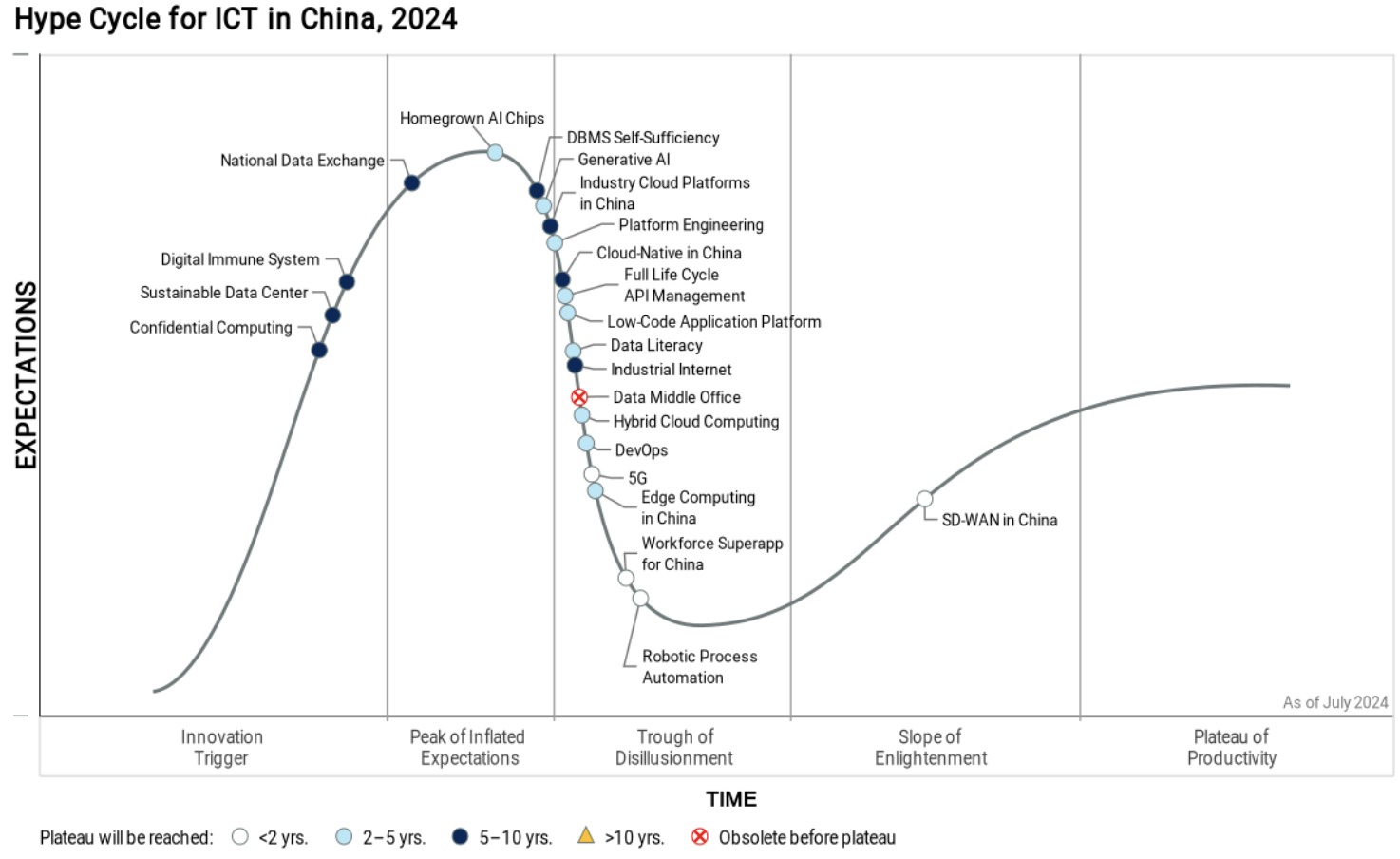来源:Gartner。
近期Gartner发布的《Hype Cycle for ICT in China, 2024》中,将全生命周期API管理收录其中。
•收益评级:高
•市场渗透率:目标受众的 5% 至 20%
•成熟度:新兴阶段

1、定义
全生命周期API管理涵盖了API的规划、设计、实施、测试、发布、运营、消费、版本控制及退役等环节。此外,这些解决方案有助于创建API产品,构建API生态系统,促进API采用,并提供业务价值报告以实现商业化。这些功能通常作为API门户、网关、设计、开发和测试解决方案的组合,以及策略管理、分析和安全措施的一部分。
Definition
Full life cycle API management involves the planning, design, implementation, testing, publication, operation, consumption, versioning and retirement of APIs. In addition, these solutions help create API products, build API ecosystems, promote API adoption and provide business value reporting to enable commercialization. These capabilities are typically packaged as a combination of API portal, gateway, design, development and testing solutions, as well as policy management, analytics and security.
2、为什么这很重要
随着云服务和微服务在中国的持续广泛发展,API正被越来越多的组织广泛使用。这些组织常常进行数字化转型以整合系统和数据。全周期API管理现已成为一项关键技术,因为对API创建、管理、运营和安全的需求日益增长。
Why This Is Important
As cloud adoption and microservices continue to evolve extensively in China, APIs are being widely used by an increasing number of organizations. These organizations often engage in digital transformation to integrate systems and data. Full cycle API management is now an essential technology due to the demand for API creation, management, operations and security.
3、业务影响
全生命周期API管理提供了管理和治理多体验应用、可组合架构和数字化转型所需的关键API的框架和工具。它使企业能够创建API产品——这些产品可能直接或间接产生收益——同时保护企业免受与API漏洞相关的商业风险。
Business Impact
Full life cycle API management provides the framework and tools needed to manage and govern APIs essential for multiexperience applications, composable architectures and digital transformation. It enables the creation of API products — which may be directly or indirectly monetized — while protecting organizations from business risks related to API breaches.
4、发展的驱动因素
•在线应用程序,例如超级应用和教育应用,正在迅速发展。中国的组织更青睐于使用 API,因为它们有助于缓解在线应用程序连通性和数据传输的重负。此外,API 还支持低代码应用平台的开发。
•无缝集成应用、数据和设备的需求正推动着 API 数量的快速增长。
•在中国,微服务和混合架构的迅速采用正使得 API 管理的复杂性日益增加。有效的 API 管理需要对 API 生命周期的完整可视性、控制能力和性能监控。
•API 不再仅仅是提供数据或应用访问的编程接口。它们可以直接(通过货币化)或间接(通过为传统业务提供新渠道)生成收入。完整生命周期的 API 管理提供了将 API 作为产品来处理的工具。
•在中国,开发者对 API 的兴趣正在增长。新的处理事件驱动 API 的方法、设计创新和建模方法,例如 GraphQL,正在推动对全生命周期 API 管理的兴趣、实验和增长。
•作为云服务、安全解决方案和其他捆绑软件应用的一部分,API 网关的商品化和广泛可用性正增加了涉及多个网关的分布式 API 管理的需求。
•在中国,全生命周期 API 管理的炒作周期位置不如全球应用那样成熟。这是因为中国的信息和通信技术(ICT)市场落后于全球市场。然而,中国市场存在巨大的增长潜力。
•生成式 AI 大型语言模型在软件工程中的影响力日益增强,这可能会增加并重塑对 API 的需求。
Drivers
•Online applications, such as superapps and educational apps, are booming. Chinese organizations prefer APIs because they help with the heavy burden of online application connectivity and data transmission. Besides, APIs enable low-code application platforms.
•The need to integrate applications, data and devices seamlessly is leading to rapid growth in the number of APIs.
•The rapid adoption of microservices and hybrid architectures in China is increasing the complexity of API management. Effective API management requires complete visibility, control and performance monitoring of the API life cycle.
•APIs are no longer just programming interfaces that provide access to data or an application. They can generate revenue directly (through monetization) or indirectly (by providing a new channel to traditional businesses). Full life cycle API management provides the tools to treat APIs as products.
•Developer interest in APIs is growing in China. New approaches to event-based APIs, design innovations and modeling methods, such as GraphQL, are driving interest, experimentation and growth in full life cycle API management.
•Commoditization and widespread availability of API gateways as part of cloud services, security solutions and other bundled software applications are increasing the need for distributed API management involving multiple gateways.
•The Hype Cycle position of full life cycle API management in China is less mature than its global applications. This is because China’s information and communication technology (ICT) market lags behind the global market. However, there is a lot of potential for growth in the China market.
•The rising influence of generative AI large language models in software engineering will likely increase and reshape the need for APIs.
5、发展阻碍
•用户对 API 的商业价值和策略存在误解,并且可能对其投资回报率(ROI)抱有不切实际的期望。这最终会降低人们对 API 的兴趣。
•缺乏对 API 安全的关注和有效管理在中国导致了许多数据泄露的案例和数据协议的违规情况。这影响了业务,并可能影响市场机会。
•传统的单一网关方式的 API 管理已不再适应现代的分布式 API 管理方法。
•一些组织认为 API 管理工具只是简单的编码,且内部开发的劳动力成本较低。他们更愿意自己管理 API。
•中国的商业用例,如电子商务,是独特且复杂的。因此,标准的 API 解决方案并不总能满足复杂的商业需求和所需的特定即席变更。全球的全生命周期 API 管理工具更为成熟,并且已经渗透到中国市场。这可能会缩小本地 API 提供商的市场机会。
Obstacles
•Users misunderstand API business value and strategy, and can have unrealistic expectations for its ROI. This ultimately reduces interest in APIs.
•Lack of focus on and effective management of API security has led to many data leakage use cases and violations of data protocols in China. This affects the business and may impact market opportunities.
•Traditional, single-gateway approaches to API management no longer adapt to modern, distributed API management approaches.
•Some organizations think API management tools are simple coding, and labor costs are lower for in-house development. They prefer to manage APIs by themselves.
•China business use cases, such as e-commerce, are unique and complex. Therefore, the standard API solution cannot always fulfill complex business requirements and the required ad hoc changes.
•Global full life cycle API management tools are much more mature and have already penetrated the China market. This can potentially shrink the market opportunities for local API providers.
6、用户建议
•利用全生命周期 API 管理来强化您的 API 策略,并解决 API 的技术和商业需求。选择那些能够满足首年之后需求的产品和服务。
•把 API 当作产品,由联合 API 平台团队中的 API 产品经理来管理。采用业务指标来衡量 API 产品的表现。
•通过与 API 产品经理合作,提高货币化 API 的采用率。
•选择一个功能广泛的 API 管理解决方案,以支持包括微服务、多网关和多云架构在内的现代 API 趋势。确保所选方案能够覆盖整个 API 生命周期,而不仅仅是运行时或操作层面。
•使用全生命周期API管理来实现对所有API的治理,包括您自己生产的和您使用的第三方API(无论是私有的还是公开的)。
•向您的全生命周期API管理供应商询问其在API维护自动化、其他功能自动化以及自动化监控和报告方面的支持情况。
User Recommendations
•Use full life cycle API management to power your API strategy and address technical and business requirements for APIs. Select offerings that can address needs well beyond the first year.
•Treat APIs as products managed by API product managers in a federated API platform team. Adopt business metrics for API products.
•Increase the adoption of monetized APIs by collaborating with API product managers.
•Select an API management solution with broad functionality to support modern API trends, including microservices, multiple gateways and multicloud architectures. Ensure the chosen solution covers the entire API life cycle, not just the runtime or operational aspects.
•Use full life cycle API management to enable governance of all APIs, not just the ones you produce, including the third-party APIs (private or public) you consume.
•Ask your full life cycle API management vendor about its support for API maintenance automation, automation of other functions, and automated monitoring and reporting.























 1478
1478

 被折叠的 条评论
为什么被折叠?
被折叠的 条评论
为什么被折叠?








